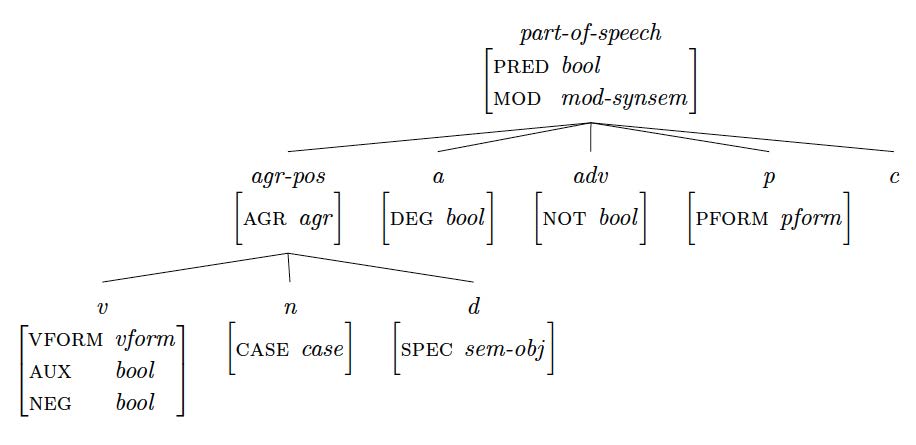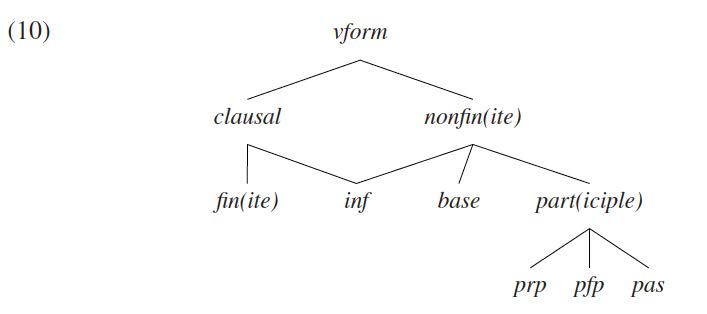Constraint-based Syntax 2: Week 4: Difference between revisions
(→Words) |
|||
| (One intermediate revision by the same user not shown) | |||
| Line 185: | Line 185: | ||
--> | --> | ||
<!-- | <!-- | ||
| Line 318: | Line 279: | ||
Navigation: | Navigation: | ||
<div align="center"> | <div align="center"> | ||
[[Constraint-based_Syntax_2| '''Main page''']] [[Constraint-based_Syntax_2:_Week_1| '''Week 1''']] [[Constraint-based_Syntax_2:_Week_2| '''Week 2''']] [[Constraint-based_Syntax_2:_Week_3| '''Week 3''']] Week4 | [[Constraint-based_Syntax_2| '''Main page''']] [[Constraint-based_Syntax_2:_Week_1| '''Week 1''']] [[Constraint-based_Syntax_2:_Week_2| '''Week 2''']] [[Constraint-based_Syntax_2:_Week_3| '''Week 3''']] Week4 [[Constraint-based_Syntax_2:_Week_5| '''Week 5''']] Week6 Week7 Week8 Week9 Week10 | ||
</div> | </div> | ||
Latest revision as of 10:02, 16 May 2017
Simplifying the Grammar of Ginzburg and Sag (2000)
Parts of Speech
Our online grammar uses the following type hierarchy for parts of speech (the values of the feature HEAD):
The hierarchy differs from that in GS in two ways:
- their type gerund is omitted (since we are not going to deal with gerunds in this class)
- the type adverb has been added.
The following table lists the parts of speech and some words belonging to them:
| Type | Full name | Examples |
|---|---|---|
| v | verb | snore, like, must, to |
| c | complementizer | that, whether, if |
| a | adjective | big, new, red |
| p | preposition | to, of, with |
| n | noun | Lilly, she |
| d | determiner | the, a, any |
| adv | adverb | early, very, not |
Head Features
The next table lists all the head features of all the parts of speech and explains their function:
| Feature | Value type | Function of the feature |
|---|---|---|
| PRED(icative) | boolean | Is the sign predicative or not? |
| MOD(ification) | mod-synsem | Can the sign modify and if yes, what kind of synsem? |
| AGR (element) | age | What are the agreement features of the sign? |
| VFORM (verb form) | vform | What is the verb's verb form? |
| AUX (iliary) | boolean | Is the verb an auxiliary? |
| Neg(aged) | boolean | Is the verb negated? |
| CASE | case | What case does the nominal sign carry? |
| SPEC(ified) | sem-obj | What is the content of the noun specified by the determiner? |
| DEG(red) | bool | Is the adjective (phrase) specified by a degree adverb? |
| NOT | boolean | Is the adverb the negation not? |
| P(reposition)FORM | form | Which preposition is it? |
The verb form hierarchy
The different verb forms that the framework makes available form another important aspect of the theory:
The table below gives an overview of all verb forms with examples:
| Verb form | Full name | Examples |
|---|---|---|
| fin | finite (indicative) | is, must, dances, dance (non-third person singular), danced (past tense) |
| inf | infinitive | to (the infinitive marker) |
| base | base form (= bare infinitive) | be, dance, call |
| prp | present participle | being, dancing, calling |
| pfp | perfect participle | been, danced, given |
| pas | passive participle | invited, rumored, introduced |
Valence
In Week 1 we saw that all signs carry the 3 valence features SUBJ, SPR, and COMPS, which are list-valued. Corresponding to each valence feature, there is a phrase type: hd-subj-ph, hd-spr-ph, and hd-comp-ph. As the names suggest, each phrase has a head daughter and additionally a SUBJ, SPR, or one or two COMPS daughters. The projection of these phrases is driven by the head daughter's valence features as illustrated in Week 1.
The linguistic objects on the valence lists (i.e. the valents) are of type synsem. In order to simplify the representations of the valents, we use the following abbreviations:
VP = a phrase of part of speech v which is COMPS <> , SPR <>, and SUBJ <synsem>
AP = a phrase of part of speech a which is COMPS <> , SPR <>, and SUBJ <synsem>
S = a phrase of part of speech v which is COMPS <>, SPR <>, and SUBJ <>
NP = a phrase of part of speech n which is COMPS <>
PP = a phrase of part of speech p which is COMPS <> , SPR <>, and SUBJ <>
This permits us to write valence lists like the following, where the information in the brackets further specify inflectional properties of the valents which should be self-explanatory:
| Example | SUBJ | COMPS |
|---|---|---|
| snores | <NP[nom]> | <> |
| likes | <NP[nom]> | <NP[acc]> |
| put | <NP> | <NP[acc],PP> |
| persuade | <NP> | <NP[acc],VP[inf]> |
| afraid | <NP> | <PP> |
| of | <> | <NP[acc]> |
| that (C) | <> | <S[fin]> |
Words
So far, we have introduced the following concepts:
- Our grammar deals with signs which are either words or phrases.
- Every sign belongs to a maximal part of speech, which may have features.
- Signs also have the 3 valence attributes SUBJ, SPR, and COMPS which contain a description of the syntactic and semantic information of other signs.
- These valence features drive the formation of specific phrases.
In preparation of a more detailed look at phrases, look at the lexical entries of the words in the table below in the online grammar. Where applicable, try out different inflectional forms, e.g. snores, snoring, snored or she, her. Pay attention to the part of speech, its features, and the 3 valence features of each word:
Online Grammar for Chapter 2: HPSG Background
| Type | Full name | Examples |
|---|---|---|
| v | verb | snore, like, must, to |
| c | complementizer | that, whether, if |
| a | adjective | big, new, red |
| p | preposition | to, of, with |
| n | noun | Lilly, she |
| d | determiner | the, a, any |
| adv | adverb | early, very, not |
Navigation:

